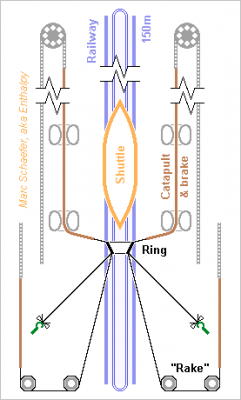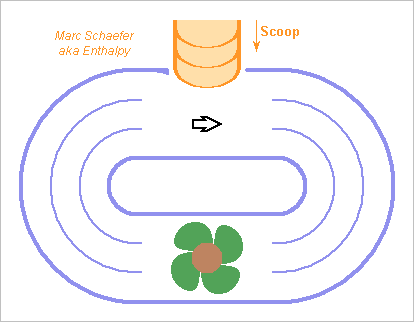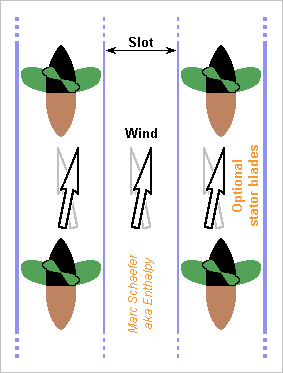-
Posts
3887 -
Joined
-
Last visited
-
Days Won
1
Content Type
Profiles
Forums
Events
Everything posted by Enthalpy
-

Why does the diffraction reflection of my green LED have red in it?
Enthalpy replied to Bluemoon's topic in Classical Physics
Why supposedly monochromatic or single-band: because datasheets tell it, as well as books, courses... Secondary radiations aren't mentioned usually, it's nice to read that the naked eye observes them. Colours in the 1980s: there was one material for red resulting directly from the bandgap; yellow and green were obtained from GaP, through a deep dopant level for yellow at least. Blue is a more recent colour, I don't quite remember if it resulted from GaN right at the beginning. A true nice blue demands a deep dopant level in GaN also. Meanwhile, GaN is used for more colours, either with a dopant level, or by conversion phosphors. -
But if the core is big enough, only its composition matters, not its density, which was my point. With present-day natural uranium, regular water won't let a core diverge. It takes a moderator that absorbs neutrons less, ilke heavy water, graphite, helium, carbon dioxide, and few others.
-

Why does the diffraction reflection of my green LED have red in it?
Enthalpy replied to Bluemoon's topic in Classical Physics
Most often, Led manufacturers try to produce light over a narrow spectrum. This was certainly the case for red, yellow and green in the 1980s. Though, the process isn't perfect. If the material's gap (or doping) gives naturally green light, the components may contain some impurity which can radiate some red through a different transition. Often also, the dopant with the desired deep level brings more deep levels, of which some may radiate. Or if the component uses a heterojunction, some carrier pairs may recombine through a secondary process. Then, there are some Led which are designed to emit in several bands. The usual case is the white Led, in which GaN produces hard blue (405nm, almost UV) which is converted in part to red and green by phosphors to produce an approximately white light. Detail: Led emit normally over a narrow band whch isn't monochromatic, because the carriers have a thermal energy (mean 25meV if in the conduction or valence band) that adds to the gap, and because heavy doping also makes the band limits a bit fuzzy. Heavy doping could also make the deep levels broader, but I doubt it's the case in a Led. Not related directly with Led, but a band diagram with a deep level is there http://www.scienceforums.net/topic/68556-preparing-gold-colloid-nanospheres/#entry703828 pretty standard diagram, so you may find a better one elsewhere. -
I'd prefer a pressure tank of CO2. Households have some to make whip cream and they're safe. I trust them better to work when needed and not before. Pure acetic acid is far too corrosive to skin - a friend got serious burns from it. Additionally, you can dilute any acid (sulphuric, phosphoric...) to be weak, and the others stink less than the acetic one. The reaction with bicarbonate takes minutes and minutes. Is that acceptable? Have you checked the necesssary amount of acid, especially after dilution? Other "foaming agents" exist for polyurethane, they look preferable than the acid+bicarbonate. Faster, less corrosive. Or check fire extinguishers. Could you inflate the ballon with air? How important is "self-contained" in regard to the very real drawbacks of acid and bicarbonate?
-
At least this website suggests FeI3: http://www.webelements.com/iron/compounds.html but (1) I understand too little of chemistry (2) The compound may be listed though it's very uncommon or unstable (3) Some websites, I believe not this one, create compounds automatically, whether they exist or not (4) I believe John Cuthber usually.
-
Salt water electrolysis uses to produce sodium hypochlorite. That would explain the yellowish colour. The odour should tell it. The rest is from the electrodes. Prefer graphite electrodes, for instance from a round battery - beware possible KOH and more in it.
-
Music and physics are strongly linked (hi Pytagoras)... It's just that a few notions (standing waves, resonances) are reasonably simple, but most other aspects are too complicated to be explained up to now. The perception of sound is poorly understood. Music instruments must be easy to play, and this is poorly understood as well. Music instruments have evolved according to observation and theories, but not theories that rely on the elementary mathematics we like, so the resulting instruments don't follow simple rules, shapes, designs. The materials used are difficult. Wood, catgut, horse tail, cane... are seriously difficult to model, but synthetic materials can't replace them because they lack the performance. As a result, music physics is seriously difficult (or would be difficult if we had some), and instruments are the difficult part of acoustics, just like antennas are the difficult part of electromagnetics.
-
It does work, including with seawater, and is computed with the usual speed times induction gives electric field - with a vector product hence angles. It is used on boats to measure the speed. Though: - It gives the local water speed, as disturbed by the hull if measured nearby - the voltage is small but metal cleanliness introduces important DC errors - the standard answer is to have an AC magnetic field, at moderate frequency to limit the direct induction by the coil 0.1m/s=0.2knt resolution and 0.1T and 0.1m need 1mV resolution, which is very little for dirty electrochemistry where 0.1V unexplained variations are normal. AC field improves that; you could rotate a permanent magnet using a coil. It looks simple, but a helix loch is still much in favour.
-
Complicated world... The horizontal speed is not conserved; it decreases at height. A way to understand it is that the "horizontal" direction changes over time, so the effect of Earth's gravity on the vertical component of speed becomes later an effect on the horizontal component. The proper theory is an elliptic orbit that follows Kepler's laws. Fortunately we don't need all details. The notion we needfrom it is that the angular momentum is conserved, and this one tells that the product of the horizontal speed by the distance to Earth's centre of mass is constant. So if vertical speed increases the distance to Earth's centre by n%, the angular velocity doesn't decrease by n% as would result from a constant horizontal speed; instead, the horizontal speed decreases by n% and the angular velocity decreases by 2n%. A factor of two won't change that. Agreed with the conclusion.
-
"Hormesis" is pseudo-science and true propaganda by the nuclear lobby. I regret it has found its way into Wikipedia. "Less harm observed than the LNT model predicts" is propaganda by the nuclear lobby, too. Any amount of ionizing radiation efficient against bacteria kills a human too.
- 28 replies
-
-1
-
Natural reactors can be big. Then density plays no role. Density only serves to intercept the neutrons before they escape the core. Have a core so big that all neutrons are absorbed, and it can have any density. With slow neutrons - this demands human intervention - a core can be critical with the present concentration of 235U; besides heavy water, one design that has worked uses graphite and carbon dioxide. At the center of Earth, provided uranium accumulates (I have still to make my opinion about it; the standard answer is "uranium goes to the crust", I doubt it), you would have all dense elements (W, Ta) as well, which precludes a chain reaction. http://www.webelements.com/tungsten/geology.html I wish we had soon a directional observatory for neutrinos of the proper energy: it would tell us where the radioactive elements are in our Earth, and what proportion of the internal heat they provide.
-
The very existence of life on Earth proves that a biosphere can work. The difficulty is that nobody on Earth knows what it needs to make a biosphere. Every single previous attempt (there have been few) has failed, and we ignore why. One difficulty is that we don't know all organisms that play a role in one biological cycle. Maybe we put 102 species in a bubble but it needs 106 to be viable and we haven't identified them. Or ppb traces of sakharovium in the atmosphere are vital and we ignore it. Neither can we exclude unwanted species in the bubble. Though, I consider humans should experiment again and again with biospheres, because it's one half-solid proof that we understand biological cycles. If a theory claims to explain nature, it's not very convincing. If it predicts an experiment outcome, far more so. The other difficulty of ecosystems is the timescale. Our experiments lasted for 1 or 2 years, but an ecosystem must work over many generations. Alone the genetic pool requires half a thousand individuals for species that need a male and a female to breed in order to limit the degeneracy and maintain some ability to adapt. This is not the same game as growing wheat under a bubble to feed astronauts. Could it be that the physical conditions for life are rather broad but that an initial biologic pool capable to maintain itself is much harder? Not having seen any single other working biosphere than Earth up to now, neither natural nor man-made, this kind of questions is more philosophy than science.
-
Hello everybody! Few vehicles have dived deep in the Ocean, with a crew or not. http://en.wikipedia.org/wiki/Bathyscaphe Very few: Piccard's ones to the deepest point of 11km around 1960, a handful much later to 5 or 7km, and recently to 11km Kaiko (lost in a typhon) http://en.wikipedia.org/wiki/Kaik%C5%8D Its successor Abismo http://en.wikipedia.org/wiki/ABISMO Nereus (lost by implosion) http://en.wikipedia.org/wiki/Nereus_(underwater_vehicle) The manned Deepsea Challenger http://en.wikipedia.org/wiki/Deepsea_Challenger The float is technically difficult. A hull that resists the 114MPa water pressure is too heavy to float, unless it uses the best materials in an optimized design. http://mseas.mit.edu/publications/Theses/Alex_Vaskov_BS_Thesis_MIT2012.pdf What has worked up to now is: Piccard used a liquid at outer pressure, lighter than water to get buoyancy and lift the heavy crew sphere. Hexane weighs 663kg/m3 without the hull and lifts little, only cryogenic gases would improve. Syntactic foam. Tiny hollow glass spheres load an epoxy to make it lighter. Not very efficient. Nereus uses many hollow spheres of alumina. This ceramic is light, stiff, and strong against compression. The spheres weigh 233kg/m3 hence outperform the previous methods but don't receive universal confidence. A float with titanium or steel shell is no alternative. If breaking at 1.5 times 114MPa, it lifts nothing - it's a candidate for 6km depth only. Maybe silica gel or some zeolite covered with a metal film would resist the pressure, but not lift much. Very hollow solid molecules exist, I don't know their strength. A hull of graphite fibre composite is widely considered, but to break at 1.5 times 114MPa, it would be heavy. ---------- I propose to help a shell with a gas at high pressure. I suggested it there already http://unmoissouslesmers.blog.lemonde.fr/2014/10/07/sous-leau-le-temps-setire/#comment-221 (sorry for ze lãnguage) and meanwhile this idea doesn't seem already common, so here are indications if any necessary. Carbon prepreg is wound on a 0.5mm titanium liner, like tanks for planes and rockets are made. The composite resists 1141Pa compression and 1712MPa tension (other manufacturers give rather 2400MPa), reduced to the half as winding makes it isotropic. Helium at 67MPa helps the shell at depth (114MPa) but must be contained at the surface. According to Soave-Redlich-Kwong, helium's density is 82kg/m3 at +4°C and 67MPa HeliumSoaveRedlichKwong.zip and at +40°C but with the hull streched by 4.6%vol, helium's pressure reaches 71MPa. A 31mm thick sphere for arbitrary D=1m resists 71MPa tension and 114-67MPa compression with 1.5 safety factor (more against buckling) and weighs 142kg. Helium adds 35kg, the liner 6kg. The 524dm3 float weighs 349kg/m3. ---------- Without the gas, the carbon composite float would weigh ~689kg/m3, and with full 114MPa gas pressure ~572kg/m3. Hydrogen is too dangerous, neon leaks less but weighs a bit. Gas pressure would help a shell of 6-2-4-6 titanium also, but the float would still weigh ~634kg/m3, and buckling demand difficult integral stiffeners. Steel is as good but makes the stiffeners more difficult. As a child I wanted to put pressure air in boats so they carry more load. Good idea after all. Marc Schaefer, aka Enthalpy
-
The wave function is more than a way to predict the probability to interact with an electron if we were using some more accurate means. First, it's a complex number with a phase, and this is fundamental for interferences, including when a particle has a complicated history before the intereference. And then, many interactions involve a particle over all its delocalization volume. For instance the emission or absorption of a photon, or the interaction between two atoms, and so on. The absorption of a photon in a small place is just one special case, deducing a theory only from that it would lead to wrong concepts. In pictures made by an atomic force microscope like Strange linked, the wave function is pretty much tangible. One more idea in an "electron cloud" is that electrons can't be distinguished, so when representing a cloud, we sum the densities over all electrons (...and then the electrons are not independent, complicated world). What's not intuitive: a particle is not only a wave. Its mass and charge spread as the squared wave amplitude would let calculate wrong results. One has to compute the behaviour of the particle with all its mass, charge and other attributes concentrated near every possible position.
-
At Windscale the conditions to ignite graphite would have been perfect: air, strong heat from an other source - but it didn't burn. Soot in an acetylene flame would have even better conditions but it doesn't burn. Oven designers use graphite as walls because it doesn't burn. I tried hard to light graphite rods with an acetylene burner and graphite doesn't burn. Not even graphite lubricating powder or fibres burn. Easy conclusion. The previously linked paper about "burning" graphite puts it in oxygen heated by a distinct source. With a separate heat source, graphite burns in hydrogen as well. Or in vacuum if you wish; I wouldn't call it burn, but sublimation is nearly as quick. Small crystals is disorder give the same X-rays diffraction pattern as a single crystal. Though, this doesn't make the same material, especially for the combustion properties. That's why graphite manufacturers spend hours and days at big heat to transform coke or tar into graphite; they regularly impregnate the parts with more tar during the process. One indication: coke's density is 1800-1950kg/m3, graphite has 2090-2230kg/m3, revealing different materials. The hydrocarbon anthracite, which has the least hydrogen among coals, has 1450-1750kg/m3.
-
It's essentially the proportion of carbon (denser) to hydrogen (lighter) that determines the density. Bigger alkanes are denser, and aromatics are denser than alkanes. Then, minor differences exist among the isomers. No direct relationship with the octane rating (which takes iso-octane as a reference), except that aromatics, when present, bring both a high octane rating and a high density. But cetane and Diesel oil are denser than iso-octane and have a very low octane rating.
-
Muons originated in cosmic rays have been used to make a picture of a volcano's depth, like X-rays make a picture of a chest. Not exactly a use, rather the prevention of an annoyance: to compute the dose affecting electronic equipment and humans in space, software takes into account varied intermediate particles produced by a cosmic ray in the radiation shield, including short-lived particles. There was some hope to use muons to catalyse nuclear fusion, but reputable people have abandoned it. Though, muons do have an indirect role in some reactor designs, like Rubbia's "energy amplifier", a sub-critical thorium reactor activated by a proton beam. This "use" is science, maybe not your query... but at Cern, in the neutrino experiment, protons create an intermediate beam prior to neutrinos - again muons if I remember properly.
-
Why not use maths? They have proven useful again and again at physics problems.
-
Our eye's diameter imposes a limit to the angular resolution, but most people (even young...) are not near to this limit. I had seen the report of an attempt to fine-machine a cornea in order to attain this limit. It supposedly failed, because the report stopped before showing the fantastic success. The cornea being of evolving material, it seems logical that an artificial perfect tune doesn't last long. Would contact lenses do the same? As a very first difficulty, one would need to place them at exactly the right position on the cornea. Do contact lenses move accurately with the eyes? Glasses don't have this function and, because they're farther away from the focus and they don't move with the eyes, it would be seriously difficult for them.
-
----- Bungees as catapult and brake Arresting an object smoothly from 180km/h without destroying it nor any brake part is very difficult. Bungees may have this capability to restart a flight immediately, and then brake more gently than crushed material. Combined with the scoop drag compensation that isn't limited by energy storage, they permit long dense sequences that cumulate hours of microgravity for experiments wanting to accumulate data. That's worth trying hard, which includes much experimenting. A ring spreads the bungee force on the shuttle. Made of woven polymer fibre (aramide and so on), it catches the guided shuttle with a limited shock and hopefully no degradation. Polymer lines to the sides and down hold it centered and well open despite the wind when it awaits the shuttle; stoppers at the main bungees instead are doubtful. More polymer lines make a rake equivalent that hold the ring and shuttle at the low point after braking, until the shuttle is brought to the proper height for the next operations. The lines rub for several turns over immobile parts, so they move only if their trailing end is loose. As the falling shuttle sinks the ring, it loosens the lines which are pulled at good pace by smaller extra bungees, whose force suffice to keep the ring in low position thanks to rubbing. Slow and accurate hardware then takes control, brings the shuttle to position, and the lines recover the wait length by loosening the bungee end combined with some positive action. It could also use a standard rake of hard material. Impossible to operate at 180km/h, this one must come in contact with the shuttle when the speed is low. It needs active decisions, but failure here isn't destructive. Individual bungee adjustment was already mentioned, as well as summing the force over the catapult stroke. Descriptions of the railway and the shuttle should come. Marc Schaefer, aka Enthalpy
-
An other layout that blows below the slot for a drag compensation scoop. This is an axial view; the air speed is mainly axial, that is, through the screen. The blowers are skewed to achieve the whirl - or use stator blades for that. Marc Schaefer, aka Enthalpy
-
This is a way to blow air upwards in a slotted tube - the downwards tube is reversed, and both can close the air circuit. This especially advantageous embodiment circulates the scoop where the fans are not, which avoids destroying them all. Nevertheless, the scoop gets good wind thanks to a whirl in the tube, so the air alternates between the fans and the slot zone. The first cause is the fan rotation; blades at the stator can adjust it, as well as tilting the fans up and down. All fans in a tube could be moved by two shaft lines, or have several motors. One tailored AC line for many squirrel cage motors looks simple, but noise may demand to synchronize all fans. The shuttle can have several scoops. Their spacing, the fans spacing, and the whirl geometric period better have an optimized relation to smoothen the operation. Marc Schaefer, aka Enthalpy Discoveries made by chance tend to be cheaper than oriented research. For instance, the synthesis of nitrocellulose by Schönbein cost only an apron - and difficult explanations to his wife probably. But is this an argument favouring random research?
-
It relates to the eye sensitivity also. Night-active animals have bigger eyes.
-
The force given for the PU part amounts to 3MPa, which is a reasonable compression load for PU. Not ridiculous at all. Anyway, 3MPa is a moderate load for a polymer, and a tiny one for a metal, which are commonly in the 200-1000MPa range. The advantage of PU is that is deforms much at 3MPa without damage, and this means much energy per volume unit. I confirm PU is the standard choice to absorb shocks. Not the materials that rebounds most nor least, but the elastomer that absorbs the biggest energy without destruction, over a wide range of impact durations. ----- An airbag saves a person's head only, thanks to a deceleration distance of 0.1m, from a speed like 40km/h or hopefully 50km/h. I've seen once a car crash-test at 70km/h and the obvious and intuitive conclusion is that you better have braked the car to a smaller speed before the impact.





